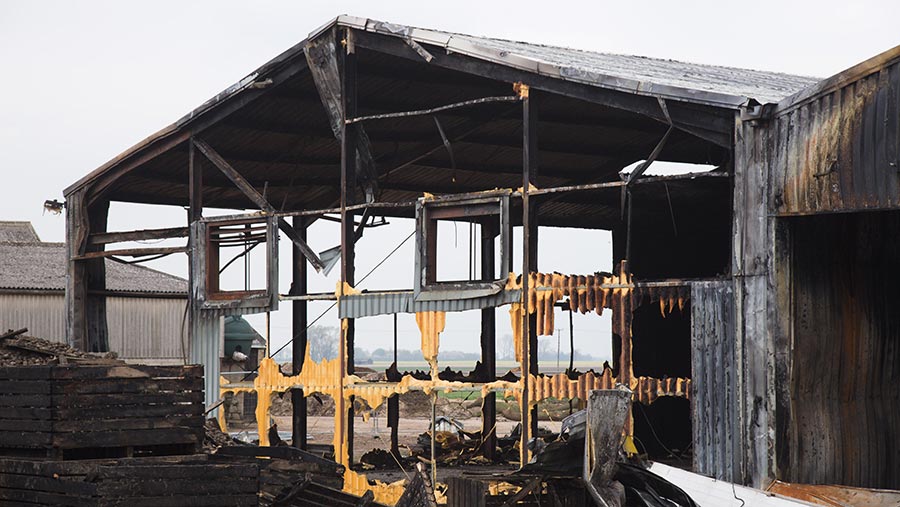How to protect your farm from fire risk and stay legal
 © Tim Scrivener
© Tim Scrivener Farm fires can be deadly and have devastating consequences for your business. Farmers are required by law to conduct a fire risk assessment to help protect all aspects of their business, including staff, livestock, buildings, machinery, crops and holiday lets.
The assessment includes steps to reduce arson risk and instructions for dealing with dangerous substances.
The three main causes of fires on farms are arson, hot works and electrics.
What the law says
The Regulatory Reform Fire Safety Order 2005 is the fire safety legislation in England and Wales that applies to all farm buildings where people work, including packing sheds, milking parlours, barns, holiday lets and farm houses used for providing bed and breakfast accommodation.
If you are a business owner, you are required to carry out a risk assessment. If you employ five or more people you are required by law to record its significant findings.
In Scotland, requirements on general fire safety are covered in Part 3 of the Fire Act 2005, supported by the Fire Safety Regulations 2006.
See also: Why on-farm water supply is critical to contain fires
Fire safety risk assessments
There are five steps to completing a fire safety risk assessment:
- Identify any hazards
- Identify any people at risk
- Evaluate, remove, reduce and protect from risk
- Record, plan, inform, instruct and train
- Review.
More information
Reduce arson risk
As part of your fire risk assessment, you should carry out a survey of farm buildings and identify any that could be a target for arsonists.
The steps for this assessment are:
- Signal crime – is there a history of vandalism or fire setting in the area around the farm? Is trespass a problem?
- Storage – is hay/straw removed from fields as soon as possible after harvest? Is it then stored separately from other farm buildings storing fuels, chemicals and machinery? Is hay and straw stored in stacks of reasonable size spaced at least 10m apart? Is hay and straw stored separately from livestock housing?
- Security – is petrol, diesel and other fuels stored securely? Are locks and intruder alarms in place and maintained regularly?
- Fire safety management – are all unoccupied areas regularly checked to ensure they are safe and secure and that there is no unnecessary accumulation of combustible materials?
Hot works
- Maintain welding and grinding equipment
- Fit flashback arrestors
- Think about the environment you are working in – can sparks dissipate safely? Are there combustible materials nearby?
- Make sure anyone welding on your farm has completed a work permit for you – this tells you the exact nature of the work they are going to do on your premises and what precautions they will take
Electrics
- Use experienced and approved contractors with a good reputation
- Stick to one plug, one socket – do not overload the socket or use multipoint adapters
- Get electrics checked and tested regularly
- Keep electric consumer units clean
Dangerous substances
Under chemical regulations you must notify people on your farm if there is a possibility that dangerous substances are involved in a fire. This includes workers, firefighters and other emergency service workers.
They will need to know the location of:
- Bottled gas, especially acetylene and LPG, and bulk diesel or petrol
- Slurry and any other animal waste
- Guns and munitions
- Asbestos in the fabric of the buildings
- Ammonium nitrate fertilisers, sodium chlorates, pesticides or any other agrochemicals and poisons.
You should be able to provide material safety data sheets for all chemicals used on your farm.
Stacking bales
- Select a site away from any potential fire hazards and sources of ignition
- Provide sufficient space to allow tractors and other vehicles room to manoeuvre
- If close to a fence or boundary, assess whether the stack needs to be fenced off
- If there is public access to the field via a footpath, consider signs to warn people to keep away
- Do not build stacks over underground services such as gas pipes or water mains and fire hydrants
- Do not work or build a stack under or within 10m of overhead power lines
Livestock evacuation plan
- Have a “fire box” at the farm entrance which tells the fire and rescue service where to move animals if they arrive first in the event of a fire
- Ensure buildings have easy access and a straight run-out to enable livestock to be evacuated quickly
- Keep gates well maintained and ensure they can swing open easily in either direction
What to do if a fire starts
- Call the fire and rescue service immediately and tell the operator:
• Where the fire is – give the full address, including the postcode
• Exactly what is involved – especially any chemicals that are at risk or likely to combust in the fire
• If access to the fire site will be difficult for the fire engines
• If there will be problems accessing water supplies on the fire site - Never attempt to fight the fire unless it is safe to do so
- If possible send someone to the farm entrance to direct the fire and rescue service to the fire. At night-time, they should have a torch and be wearing high-visibility clothing so they are easy to see
- Clear access routes to the fire site for the fire engines
- Move livestock if necessary, or be prepared to move them in case the fire spreads
- Make yourself known to the fire crew on arrival and answer any questions they may have
